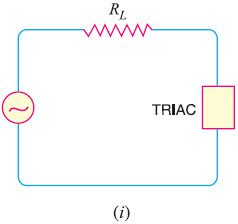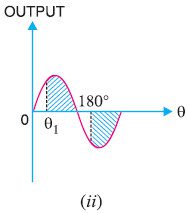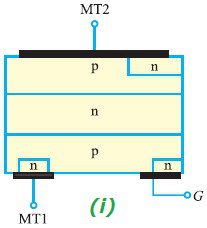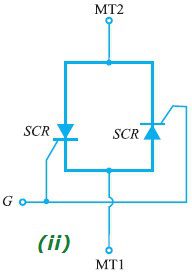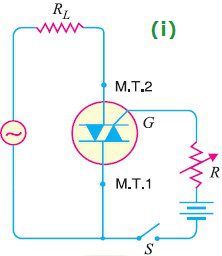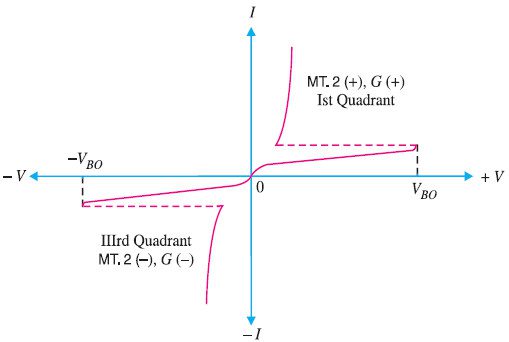What is TRIAC ?
The major drawback of an SCR is that it can conduct current in one direction only.Therefore, an SCR can only control d.c. power or forward biased half-cycles of a.c. in a load.However, in an a.c. system, it is often desirable and necessary to exercise control over both positive and negative half cycles.For this purpose, a semiconductor device called triac is used.
A triac is a three-terminal semiconductor switching device which can control alternating current in a load.
Triac is an abbreviation for triode a.c. switch. ‘Tri’– indicates that the device has three terminals and ‘ac’ means that the device controls alternating current or can conduct current in either direction.
The key function of a triac may be understood by referring to figure (i). The control circuit of triac can be adjusted to pass the desired portions of positive and negative half cycle of a.c. supply through the load RL.Thus referring to figure (ii), the triac passes the positive half-cycle of the supply from θ1 to 180° i.e. the shaded portion of positive half-cycle. Similarly,the shaded portion of negative half-cycle will pass through the load.In this way, the alternating current and hence a.c. power flowing through the load can be controlled.
Since a triac can control conduction of both positive and negative half-cycles of a.c. supply, it is sometimes called a bidirectional semiconductor triode switch.The above action of a triac is certainly not a rectifying action (as in an SCR ) so that the triac makes no mention of rectification in its name.
Construction of Triac:
A triac is a three-terminal,five-layer semiconductor device whose forward and reverse characteristics are indentical to the forward characteristics of the SCR. The three terminals are designated as main terminal MT1, main terminal MT2 and gate G.
Figure (i) shows the construction of triac. As we shall see, a triac is equivalent to two separate SCRs connected in inverse parallel (i.e. anode of each connected to the cathode of the other) with gates commoned as shown in figure (ii). Therefore, a triac acts like a bidirectional switch i.e. it can conduct current in either direction.This is unlike an SCR which can conduct current only in one direction.Figure (iii) shows the schematic symbol construction of a triac. The symbol consists of two parallel diodes connected in opposite directions with a single gate lead. It can be seen that even the symbol of triac indicates that it can conduct current for either polarity of the main terminals (MT1 and MT2) i.e. it can act as a bidirectional switch.The gate provides control over conduction in either direction.
The following points many be noted about the triac :
(i) The triac can conduct current (of course with proper gate current) regardless of the polarities of the main terminals MT1 and MT2. Since there is no longer a specific anode or cathode, the main leads are referred to as MT1 and MT2.
(ii) A triac can be turned on either with a positive or negative voltage at the gate of the device.
(iii) Like the SCR, once the triac is fired into conduction, the gate loses all control.The triac can be turned off by reducing the circuit current to the value of holding current.
(iv) The main disadvantage of triacs over SCRs is that triacs have considerably lower current handling capabilities.Most triacs are available in ratings of less than 40A at voltages up to 600V.
Operation of Triac:
Figure (i) shows the operation of triac circuit.The a.c. supply to be controlled is connected across the main terminals of triac through a load resistance RL.The gate circuit consists of battery, a current limiting resistor R and a switch S.The
circuit action is as follows :
(i) With switch S open, there will be no gate current and the triac is cut off.Even with no gate current, the triac can be turned on provided the supply voltage becomes equal to the breakover voltage of triac.However, the normal way to turn on a triac is by introducing a proper gate current.
(ii) When switch S is closed, the gate current starts flowing in the gate circuit. In a similar manner to SCR, the breakover voltage of the triac can be varied by making proper gate current to flow.With a few milliamperes introduced at the gate, the triac will start conducting whether terminal MT2 is positive or negative w.r.t. MT1.
(iii)If terminal MT2 is positive w.r.t. MT1, the triac turns on and the conventional current will flow from MT2 to MT1. If the terminal MT2 is negative w.r.t. MT1, the triac is again turned on but this time the conventional current flows from MT1 to MT2.
The above operation of triac reveals that it can act as an a.c. contactor to switch on or off alternating current to a load.The additional advantage of triac is that by adjusting the gate current to a proper value, any portion of both positive and negative half-cycles of a.c. supply can be made to flow through the load.This permits to adjust the transfer of a.c. power from the source to the load.This is how a triac works.
Characteristics of Triac:
Figure (i) shows the V-I characteristics of a triac.Because the triac essentially consists of two SCRs of opposite orientation fabricated in the same crystal, its operating characteristics in the first and third quadrants are the same except for the direction of applied voltage and current flow. The following points may be noted from the triac characteristics :
(i) The V-I characteristics for triac in the Ist and IIIrd quadrants are essentially identical to those of an SCR in the Ist quadrant.
(ii) The triac can be operated with either positive or negative gate control voltage but in normal operation usually the gate voltage is positive in quadrant I and negative in quadrant III.
(iii) The supply voltage at which the triac is turned ON depends upon the gate current.The greater the gate current, the smaller the supply voltage at which the triac is turned on.This permits to use a triac to control a.c. power in a load from zero to full power in a smooth and continuous manner with no loss in the controlling device.
